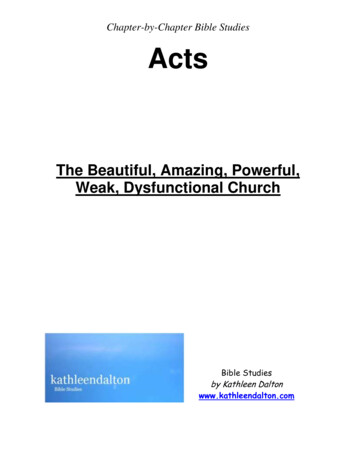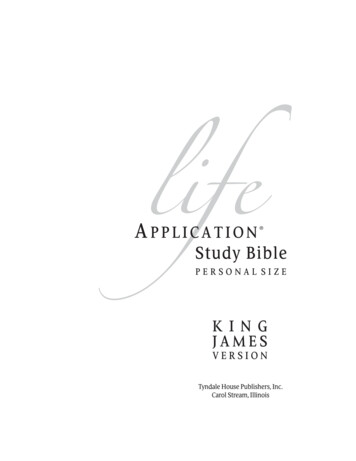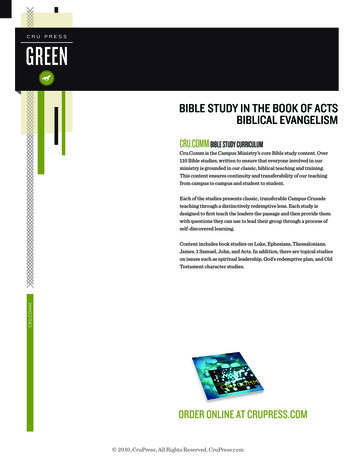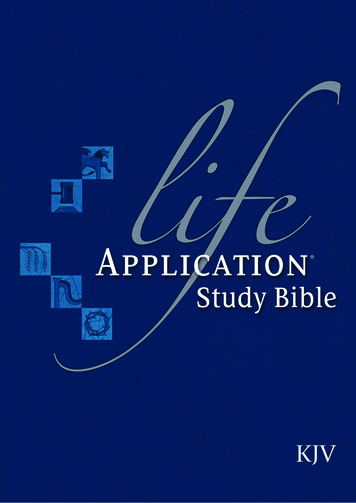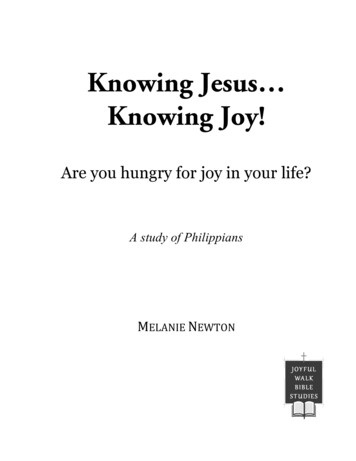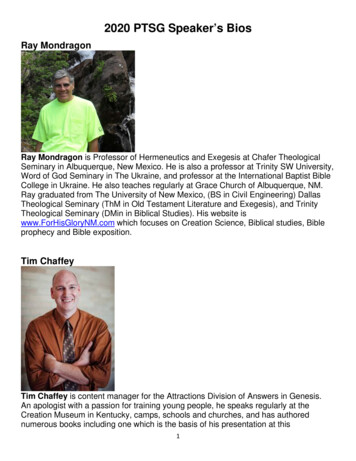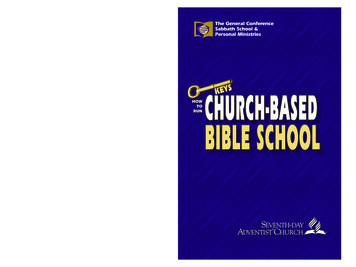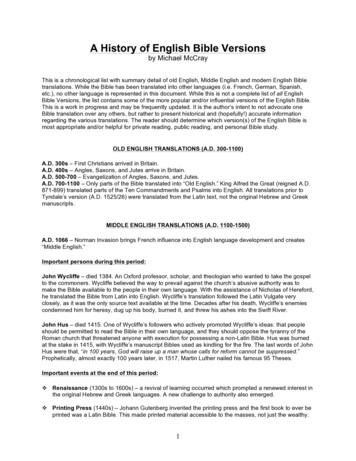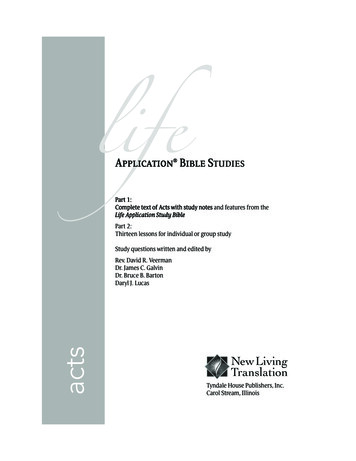
Transcription
lifefStudiess and features from thePart 2:Thirteen lessons for individual or group studyStudy questions written and edited byactsRev. David R. VeermanDr. James C. GalvinDr. Bruce B. BartonDaryl J. LucasActsFM.indd iiiNew LivinggTranslationTyndale House Publishers, Inc.Carol Stream, Illinois8/28/2008 9:44:43 AM
Visit Tyndale’s exciting Web site at www.tyndale.comNew Living Translation, NLT, the New Living Translation logo, and Life Application are registered trademarks of TyndaleHouse Publishers, Inc.Life Application Bible Studies: ActsCopyright 1999, 2008 by Tyndale House Publishers, Inc., Carol Stream, Illinois 60188. All rights reserved.Life Application notes and features copyright 1988, 1989, 1990, 1991, 1993, 1996, 2004 by Tyndale House Publishers,Inc., Carol Stream, Illinois 60188. Maps in text copyright 1986, 1988 by Tyndale House Publishers, Inc. All rightsreserved.Cover photograph copyright by Jacob Wackerhausen/iStockphoto. All rights reserved.The text of Acts is from the Holy Bible, New Living Translation, copyright 1996, 2004, 2007 by Tyndale HouseFoundation. All rights reserved.The text of the Holy Bible, New Living Translation, may be quoted in any form (written, visual, electronic, or audio) up toand inclusive of five hundred (500) verses without express written permission of the publisher, provided that the versesquoted do not account for more than 25 percent of the work in which they are quoted, and provided that a completebook of the Bible is not quoted.When the Holy Bible, New Living Translation, is quoted, one of the following credit lines must appear on the copyrightpage or title page of the work:Scripture quotations are taken from the Holy Bible, New Living Translation, copyright 1996, 2004, 2007 byTyndale House Foundation. Used by permission of Tyndale House Publishers, Inc., Carol Stream, Illinois 60188.All rights reserved.Unless otherwise indicated, all Scripture quotations are taken from the Holy Bible, New Living Translation, copyright 1996, 2004, 2007 by Tyndale House Foundation. Used by permission of Tyndale House Publishers, Inc., CarolStream, Illinois 60188. All rights reserved.Scripture quotations marked NLT are taken from the Holy Bible, New Living Translation, copyright 1996, 2004,2007 by Tyndale House Foundation. Used by permission of Tyndale House Publishers, Inc., Carol Stream, Illinois60188. All rights reserved.When quotations from the NLT text are used in nonsalable media, such as church bulletins, orders of service, newsT must appearletters, transparencies, or similar media, a complete copyright notice is not required, but the initials NLTat the end of each quotation.Quotations in excess of five hundred (500) verses or 25 percent of the work, or other permission requests, must beapproved in writing by Tyndale House Publishers, Inc. Send requests by e-mail to: permission@tyndale.com or call630-668-8300, ext. 8817.Publication of any commentary or other Bible reference work produced for commercial sale that uses the New LivingTranslation requires written permission for use of the NLT text.ISBN-13: 978-1-4143-2562-0ISBN-10: 1-4143-2562-2Printed in the United States of America147ActsFM.indd iv13 12 11 10 09 086543218/28/2008 9:44:43 AM
CONTENTSviiiixxxvvxviiixixx3ActsFM.indd vA Note to ReadersIntroduction to the New Living TranslationWhy the Life Application Study Biblee Is UniqueWhat Is Application?Features of the Life Application Study BibleACTS from the Life Application Study Bible855How to Use This Bible Study877Lesson 1: Spreading like WildfireActs Introduction91Lesson 2: Turning On the PowerActs 1:1–2:47955Lesson 3: Speak Up!Acts 3:1–4:31999Lesson 4: Famous Last WordsActs 4:32–8:1a1033Lesson 5: It Takes All KindsActs 8:1b–10:481077Lesson 6: A Night SurpriseActs 11:1–12:25111Lesson 7: Bringing Out the BestActs 13:1–14:281155Lesson 8: Coming TogetherActs 15:1-351199Lesson 9: Land of OpportunitiesActs 15:36–18:231233Lesson 10: New WorthActs 18:24–21:141277Lesson 11: Don’t Confuse Me with the FactsActs 21:15–23:22131Lesson 12: Follow the LeaderActs 23:23–26:321355Lesson 13: He’s Got the Whole World in His HandsActs 27:1–28:318/28/2008 9:44:43 AM
A NOTE TO READERSThe Holy Bible, New Living Translation, was first published in 1996. It quickly becameone of the most popular Bible translations in the English-speaking world. While the NLT’sinfluence was rapidly growing, the Bible Translation Committee determined that an additional investment in scholarly review and text refinement could make it even better. Soshortly after its initial publication, the committee began an eight-year process with thepurpose of increasing the level of the NLT’s precision without sacrificing its easy-tounderstand quality. This second-generation text was completed in 2004 and is reflectedin this edition of the New Living Translation. An additional update with minor changes wassubsequently introduced in 2007.The goal of any Bible translation is to convey the meaning and content of the ancientHebrew, Aramaic, and Greek texts as accurately as possible to contemporary readers. Thechallenge for our translators was to create a text that would communicate as clearly andpowerfully to today’s readers as the original texts did to readers and listeners in the ancientbiblical world. The resulting translation is easy to read and understand, while also accurately communicating the meaning and content of the original biblical texts. The NLT is ageneral-purpose text especially good for study, devotional reading, and reading aloud inworship services.We believe that the New Living Translation—which combines the latest biblical scholarship with a clear, dynamic writing style—will communicate God’s word powerfully to allwho read it. We publish it with the prayer that God will use it to speak his timeless truth tothe church and the world in a fresh, new way.The PublishersOctober 2007ActsFM.indd vii8/28/2008 9:44:43 AM
INTRODUCTION TO THENEW LIVING TRANSLATIONTranslation Philosophy and MethodologyEnglish Bible translations tend to be governed by one of two general translation theories.The first theory has been called “formal-equivalence,” “literal,” or “word-for-word” translation. According to this theory, the translator attempts to render each word of the originallanguage into English and seeks to preserve the original syntax and sentence structure asmuch as possible in translation. The second theory has been called e,” or “thought-for-thought” translation. The goal of this translationtheory is to produce in English the closest natural equivalent of the message expressed bythe original-language text, both in meaning and in style.Both of these translation theories have their strengths. A formal-equivalence translationpreserves aspects of the original text—including ancient idioms, term consistency, andoriginal-language syntax—that are valuable for scholars and professional study. It allowsa reader to trace formal elements of the original-language text through the English translation. A dynamic-equivalence translation, on the other hand, focuses on translating themessage of the original-language text. It ensures that the meaning of the text is readily apparent to the contemporary reader. This allows the message to come through with immediacy, without requiring the reader to struggle with foreign idioms and awkward syntax. Italso facilitates serious study of the text’s message and clarity in both devotional and publicreading.The pure application of either of these translation philosophies would create translationsat opposite ends of the translation spectrum. But in reality, all translations contain a mixtureof these two philosophies. A purely formal-equivalence translation would be unintelligiblein English, and a purely dynamic-equivalence translation would risk being unfaithful to theoriginal. That is why translations shaped by dynamic-equivalence theory are usually quiteliteral when the original text is relatively clear, and the translations shaped by formalequivalence theory are sometimes quite dynamic when the original text is obscure.The translators of the New Living Translation set out to render the message of the originaltexts of Scripture into clear, contemporary English. As they did so, they kept the concerns ofboth formal-equivalence and dynamic-equivalence in mind. On the one hand, they translated as simply and literally as possible when that approach yielded an accurate, clear, andnatural English text. Many words and phrases were rendered literally and consistently intoEnglish, preserving essential literary and rhetorical devices, ancient metaphors, and wordchoices that give structure to the text and provide echoes of meaning from one passage tothe next.On the other hand, the translators rendered the message more dynamically when theliteral rendering was hard to understand, was misleading, or yielded archaic or foreign wording. They clarified difficult metaphors and terms to aid in the reader’s understanding. Thetranslators first struggled with the meaning of the words and phrases in the ancient context;then they rendered the message into clear, natural English. Their goal was to be both faithfulto the ancient texts and eminently readable. The result is a translation that is both exegetically accurate and idiomatically powerful.Translation Process and TeamTo produce an accurate translation of the Bible into contemporary English, the translationteam needed the skills necessary to enter into the thought patterns of the ancient authorsand then to render their ideas, connotations, and effects into clear, contemporary English.ActsFM.indd ix8/28/2008 9:44:43 AM
I N T R O D U C T I O N T O T H E N E W L I V I N G T R A N S L AT I O NxTo begin this process, qualified biblical scholars were needed to interpret the meaning ofthe original text and to check it against our base English translation. In order to guardagainst personal and theological biases, the scholars needed to represent a diverse group ofevangelicals who would employ the best exegetical tools. Then to work alongside the scholars, skilled English stylists were needed to shape the text into clear, contemporary English.With these concerns in mind, the Bible Translation Committee recruited teams of scholars that represented a broad spectrum of denominations, theological perspectives, andbackgrounds within the worldwide evangelical community. Each book of the Bible was assigned to three different scholars with proven expertise in the book or group of books to bereviewed. Each of these scholars made a thorough review of a base translation and submitted suggested revisions to the appropriate Senior Translator. The Senior Translator then reviewed and summarized these suggestions and proposed a first-draft revision of the basetext. This draft served as the basis for several additional phases of exegetical and stylisticcommittee review. Then the Bible Translation Committee jointly reviewed and approvedevery verse of the final translation.Throughout the translation and editing process, the Senior Translators and their scholarteams were given a chance to review the editing done by the team of stylists. This ensured thatexegetical errors would not be introduced late in the process and that the entire Bible Translation Committee was happy with the final result. By choosing a team of qualified scholarsand skilled stylists and by setting up a process that allowed their interaction throughout theprocess, the New Living Translation has been refined to preserve the essential formal elements of the original biblical texts, while also creating a clear, understandable English text.The New Living Translation was first published in 1996. Shortly after its initial publication, the Bible Translation Committee began a process of further committee review and translation refinement. The purpose of this continued revision was to increase the level of precisionwithout sacrificing the text’s easy-to-understand quality. This second-edition text was completed in 2004, and an additional update with minor changes was subsequently introducedin 2007. This printing of the New Living Translation reflects the updated 2007 text.Written to Be Read AloudIt is evident in Scripture that the biblical documents were written to be read aloud, often inpublic worship (see Nehemiah 8; Luke 4:16-20; 1 Timothy 4:13; Revelation 1:3). It is still thecase today that more people will hear the Bible read aloud in church than are likely to read itfor themselves. Therefore, a new translation must communicate with clarity and powerwhen it is read publicly. Clarity was a primary goal for the NLT translators, not only to facilitate private reading and understanding, but also to ensure that it would be excellent for public reading and make an immediate and powerful impact on any listener.The Texts behind the New Living TranslationThe Old Testament translators used the Masoretic Text of the Hebrew Bible as representedin Biblia Hebraica Stuttgartensia (1977), with its extensive system of textual notes; this is anupdate of Rudolf Kittel’s Biblia Hebraica (Stuttgart, 1937). The translators also further compared the Dead Sea Scrolls, the Septuagint and other Greek manuscripts, the Samaritan Pentateuch, the Syriac Peshitta, the Latin Vulgate, and any other versions or manuscripts thatshed light on the meaning of difficult passages.The New Testament translators used the two standard editions of the Greek New Testament: the Greek New Testament, published by the United Bible Societies (UBS, fourth revised edition, 1993), and Novum Testamentum Graece, edited by Nestle and Aland (NA,twenty-seventh edition, 1993). These two editions, which have the same text but differ inpunctuation and textual notes, represent, for the most part, the best in modern textualscholarship. However, in cases where strong textual or other scholarly evidence supportedthe decision, the translators sometimes chose to differ from the UBS and NA Greek textsand followed variant readings found in other ancient witnesses. Significant textual variantsof this sort are always noted in the textual notes of the New Living Translation.Translation IssuesThe translators have made a conscious effort to provide a text that can be easily understoodby the typical reader of modern English. To this end, we sought to use only vocabulary andActsFM.indd x8/28/2008 9:44:44 AM
xiI N T R O D U C T I O N T O T H E N E W L I V I N G T R A N S L AT I O Nlanguage structures in common use today. We avoided using language likely to becomequickly dated or that reflects only a narrow subdialect of English, with the goal of makingthe New Living Translation as broadly useful and timeless as possible.But our concern for readability goes beyond the concerns of vocabulary and sentencestructure. We are also concerned about historical and cultural barriers to understanding theBible, and we have sought to translate terms shrouded in history and culture in ways that canbe immediately understood. To this end: ActsFM.indd xiWe have converted ancient weights and measures (for example, “ephah” [a unit ofdry volume] or “cubit” [a unit of length]) to modern English (American) equivalents,since the ancient measures are not generally meaningful to today’s readers. Then inthe textual footnotes we offer the literal Hebrew, Aramaic, or Greek measures, alongwith modern metric equivalents.Instead of translating ancient currency values literally, we have expressed them incommon terms that communicate the message. For example, in the Old Testament,“ten shekels of silver” becomes “ten pieces of silver” to convey the intendedmessage. In the New Testament, we have often translated the “denarius” as “thenormal daily wage” to facilitate understanding. Then a footnote offers: “Greek adenarius, the payment for a full day’s wage.” In general, we give a clear Englishrendering and then state the literal Hebrew, Aramaic, or Greek in a textual footnote.Since the names of Hebrew months are unknown to most contemporary readers, andsince the Hebrew lunar calendar fluctuates from year to year in relation to the solarcalendar used today, we have looked for clear ways to communicate the time of yearthe Hebrew months (such as Abib) refer to. When an expanded or interpretiverendering is given in the text, a textual note gives the literal rendering. Where it ispossible to define a specific ancient date in terms of our modern calendar, we usemodern dates in the text. A textual footnote then gives the literal Hebrew date andstates the rationale for our rendering. For example, Ezra 6:15 pinpoints the datewhen the postexilic Temple was completed in Jerusalem: “the third day of themonth Adar.” This was during the sixth year of King Darius’s reign (that is, 515 b.c.).We have translated that date as March 12, with a footnote giving the Hebrew andidentifying the year as 515 b.c.Since ancient references to the time of day differ from our modern methods ofdenoting time, we have used renderings that are instantly understandable to themodern reader. Accordingly, we have rendered specific times of day by using approximate equivalents in terms of our common “o’clock” system. On occasion, translations such as “at dawn the next morning” or “as the sun was setting” have been usedwhen the biblical reference is more general.When the meaning of a proper name (or a wordplay inherent in a proper name) isrelevant to the message of the text, its meaning is often illuminated with a textualfootnote. For example, in Exodus 2:10 the text reads: “The princess named himMoses, for she explained, ‘I lifted him out of the water.’ ” The accompanying footnotereads: ““Moses sounds like a Hebrew term that means ‘to lift out.’ ”Sometimes, when the actual meaning of a name is clear, that meaning is includedin parentheses within the text itself. For example, the text at Genesis 16:11 reads:“You are to name him Ishmael (which means ‘God hears’), for the Lord has heardyour cry of distress.” Since the original hearers and readers would have instantlyunderstood the meaning of the name “Ishmael,” we have provided modern readerswith the same information so they can experience the text in a similar way.Many words and phrases carry a great deal of cultural meaning that was obviousto the original readers but needs explanation in our own culture. For example, thephrase “they beat their breasts” (Luke 23:48) in ancient times meant that peoplewere very upset, often in mourning. In our translation we chose to translate thisphrase dynamically for clarity: “They went home in deep sorrow.” Then we includeda footnote with the literal Greek, which reads: “Greek went home beating theirbreasts.” In other similar cases, however, we have sometimes chosen to illuminatethe existing literal expression to make it immediately understandable. For example,here we might have expanded the literal Greek phrase to read: “They went home8/28/2008 9:44:44 AM
I N T R O D U C T I O N T O T H E N E W L I V I N G T R A N S L AT I O N xiibeating their breasts in sorrow.” If we had done this, we would not have includeda textual footnote, since the literal Greek clearly appears in translation.Metaphorical language is sometimes difficult for contemporary readers to understand, so at times we have chosen to translate or illuminate the meaning of ametaphor. For example, the ancient poet writes, “Your neck is like the tower ofDavid” (Song of Songs 4:4). We have rendered it “Your neck is as beautiful as thetower of David” to clarify the intended positive meaning of the simile. Anotherexample comes in Ecclesiastes 12:3, which can be literally rendered: “Rememberhim . . . when the grinding women cease because they are few, and the womenwho look through the windows see dimly.” We have rendered it: “Remember himbefore your teeth—your few remaining servants—stop grinding; and before youreyes—the women looking through the windows—see dimly.” We clarified suchmetaphors only when we believed a typical reader might be confused by theliteral text.When the content of the original language text is poetic in character, we haverendered it in English poetic form. We sought to break lines in ways that clarifyand highlight the relationships between phrases of the text. Hebrew poetry oftenuses parallelism, a literary form where a second phrase (or in some instances a thirdor fourth) echoes the initial phrase in some way. In Hebrew parallelism, the subsequent parallel phrases continue, while also furthering and sharpening, the thoughtexpressed in the initial line or phrase. Whenever possible, we sought to representthese parallel phrases in natural poetic English.The Greek term hoi Ioudaioi is literally translated “the Jews” in many English translations. In the Gospel of John, however, this term doesn’t always refer to the Jewishpeople generally. In some contexts, it refers more particularly to the Jewish religiousleaders. We have attempted to capture the meaning in these different contexts byusing terms such as “the people” (with a footnote: Greek the Jewish people) or “thereligious leaders,” where appropriate.One challenge we faced was how to translate accurately the ancient biblical text thatwas originally written in a context where male-oriented terms were used to refer tohumanity generally. We needed to respect the nature of the ancient context whilealso trying to make the translation clear to a modern audience that tends to readmale-oriented language as applying only to males. Often the original text, thoughusing masculine nouns and pronouns, clearly intends that the message be appliedto both men and women. A typical example is found in the New Testament letters,where the believers are called “brothers” (adelphoi). Yet it is clear from the contentof these letters that they were addressed to all the believers—male and female. Thus,we have usually translated this Greek word as “brothers and sisters” in order torepresent the historical situation more accurately.We have also been sensitive to passages where the text applies generally tohuman beings or to the human condition. In some instances we have used pluralpronouns (they, them) in place of the masculine singular (he, him). For example, atraditional rendering of Proverbs 22:6 is: “Train up a child in the way he should go,and when he is old he will not turn from it.” We have rendered it: “Direct your children onto the right path, and when they are older, they will not leave it.” At times, wehave also replaced third person pronouns with the second person to ensure clarity.A traditional rendering of Proverbs 26:27 is: “He who digs a pit will fall into it, andhe who rolls a stone, it will come back on him.” We have rendered it: “If you set a trapfor others, you will get caught in it yourself. If you roll a boulder down on others, itwill crush you instead.”We should emphasize, however, that all masculine nouns and pronouns used torepresent God (for example, “Father”) have been maintained without exception. Alldecisions of this kind have been driven by the concern to reflect accurately theintended meaning of the original texts of Scripture.Lexical Consistency in TerminologyFor the sake of clarity, we have translated certain original-language terms consistently, especially within synoptic passages and for commonly repeated rhetorical phrases, and withinActsFM.indd xii8/28/2008 9:44:44 AM
xiiiI N T R O D U C T I O N T O T H E N E W L I V I N G T R A N S L AT I O Ncertain word categories such as divine names and non-theological technical terminology(e.g., liturgical, legal, cultural, zoological, and botanical terms). For theological terms, wehave allowed a greater semantic range of acceptable English words or phrases for a singleHebrew or Greek word. We have avoided some theological terms that are not readily understood by many modern readers. For example, we avoided using words such as “justification”and “sanctification,” which are carryovers from Latin translations. In place of these words,we have provided renderings such as “made right with God” and “made holy.”The Spelling of Proper NamesMany individuals in the Bible, especially the Old Testament, are known by more than onename (e.g., Uzziah/Azariah). For the sake of clarity, we have tried to use a single spelling forany one individual, footnoting the literal spelling whenever we differ from it. This is especially helpful in delineating the kings of Israel and Judah. King Joash/Jehoash of Israel hasbeen consistently called Jehoash, while King Joash/Jehoash of Judah is called Joash. A similar distinction has been used to distinguish between Joram/Jehoram of Israel and Joram/Jehoram of Judah. All such decisions were made with the goal of clarifying the text for thereader. When the ancient biblical writers clearly had a theological purpose in their choice ofa variant name (e.g., Esh-baal/Ishbosheth), the different names have been maintained withan explanatory footnote.For the names Jacob and Israel, which are used interchangeably for both the individualpatriarch and the nation, we generally render it “Israel” when it refers to the nation and“Jacob” when it refers to the individual. When our rendering of the name differs from theunderlying Hebrew text, we provide a textual footnote, which includes this explanation:“The names ‘Jacob’ and ‘Israel’ are often interchanged throughout the Old Testament, referring sometimes to the individual patriarch and sometimes to the nation.”The Rendering of Divine NamesAll appearances of ’el, ’elohim, or ’eloah have been translated “God,” except where the context demands the translation “god(s).” We have generally rendered the tetragrammaton(YHWH)H consistently as “the Lord,” utilizing a form with small capitals that is commonamong English translations. This will distinguish it from the name ’adonai, which we render“Lord.” When ’adonai and YHWHH appear together, we have rendered it “Sovereign Lord.”This also distinguishes ’adonai YHWHH from cases where YHWHH appears with ’elohim, whichis rendered “Lord God.” When YHH (the short form of YHWH)H and YHWHH appear together,we have rendered it “Lord God.” When YHWHH appears with the term tseba’oth, we haverendered it “Lord of Heaven’s Armies” to translate the meaning of the name. In a few cases,we have utilized the transliteration, Yahweh, when the personal character of the name is being invoked in contrast to another divine name or the name of some other god (for example,see Exodus 3:15; 6:2-3).In the New Testament, the Greek word christos has been translated as “Messiah” when thecontext assumes a Jewish audience. When a Gentile audience can be assumed, christos hasbeen translated as “Christ.” The Greek word kurios is consistently translated “Lord,” exceptthat it is translated “Lord” wherever the New Testament text explicitly quotes from the OldTestament, and the text there has it in small capitals.Textual FootnotesThe New Living Translation provides several kinds of textual footnotes, all designated in thetext with an asterisk: ActsFM.indd xiiiWhen for the sake of clarity the NLT renders a difficult or potentially confusingphrase dynamically, we generally give the literal rendering in a textual footnote. Thisallows the reader to see the literal source of our dynamic rendering and how ourtranslation relates to other more literal translations. These notes are prefaced with“Hebrew,” “Aramaic,” or “Greek,” identifying the language of the underlying sourcetext. For example, in Acts 2:42 we translated the literal “breaking of bread” (from theGreek) as “the Lord’s Supper” to clarify that this verse refers to the ceremonial practice of the church rather than just an ordinary meal. Then we attached a footnote to“the Lord’s Supper,” which reads: “Greek the breaking of bread.”8/28/2008 9:44:44 AM
I N T R O D U C T I O N T O T H E N E W L I V I N G T R A N S L AT I O N xivTextual footnotes are also used to show alternative renderings, prefaced with theword “Or.” These normally occur for passages where an aspect of the meaning isdebated. On occasion, we also provide notes on words or phrases that represent adeparture from long-standing tradition. These notes are prefaced with “Traditionally rendered.” For example, the footnote to the translation “serious skin disease”at Leviticus 13:2 says: “Traditionally rendered leprosy. The Hebrew word usedthroughout this passage is used to describe various skin diseases.”When our translators follow a textual variant that differs significantly from our standard Hebrew or Greek texts (listed earlier), we document that difference with a footnote. We also footnote cases when the NLT excludes a passage that is included in theGreek text known as the Textus Receptus (and familiar to readers through its translation in the King James Version). In such cases, we offer a translation of the excludedtext in a footnote, even though it is generally recognized as a later addition to theGreek text and not part of the original Greek New Testament.All Old Testament passages that are quoted in the New Testament are identified bya textual footnote at the New Testament location. When the New Testament clearlyquotes from the Greek translation of the Old Testament, and when it differs significantly in wording from the Hebrew text, we also place a textual footnote at the OldTestament location. This note includes a rendering of the Greek version, along witha cross-reference to the New Testament passage(s) where it is cited (for example, seenotes on Proverbs 3:12; Psalms 8:2; 53:3).Some textual footnotes provide cultural and historical information on places, things,and people in the Bible that are probably obscure to modern readers. Such notesshould aid the reader in understanding the message of the text. For example, in Acts12:1, “King Herod” is named in this translation as “King Herod Agrippa” and is identified in a footnote as being “the nephew of Herod Antipa
CONTENTS viii A Note to Readers ixx Introduction to the New Living Translation xvv Why the Life Application Study Biblee Is Unique xviii What Is Application? xixx Features of the Life Application Study Bible 3 ACTS from the Life Application Study Bible 855 How to Use This Bible Study 877 Lesson 1:Spreading like Wildfi re Acts Introduction 91 Lesson 2: Turning On the PowerFile Size: 513KB

